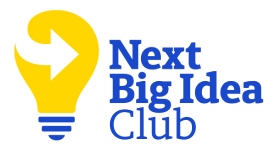Christie Aschwanden is an award-winning science journalist and a former elite athlete. She’s a contributor to the New York Times, Washington Post, and Slate, and was previously the lead science writer for FiveThirtyEight. Christie recently sat down with Next Big Idea Club Editor Jeremy Price to discuss why eating healthy is easier than you think, and share valuable insights from her book, Good to Go: What the Athlete in All of Us Can Learn from the Strange Science of Recovery, out now in paperback.
This conversation has been edited and condensed. To watch the full version, click the video below.
Jeremy: I was really surprised by how many insights there were [in Good to Go], not just for athletes, but also for people simply looking to take care of their body and stay healthy. Tell me about your background, and how this book first came about.
Christie: I’ve been an athlete since I was a teenager. In high school I went out for the volleyball team, but it turns out I’m totally uncoordinated—I didn’t even make the D team. But the cross country team took anyone, so I joined that, and it turned out that I was actually quite good at running. By the end of my freshman season, I was the top runner on the team.
Then I was a runner in college at the University of Colorado, but while I was there, I got injured. I started cycling for rehab and really liked biking, so I became a bike racer for a while. But then after I went to a graduate program, I came back and decided that I wanted to pursue cross-country skiing. I did that for about eight years, traveling all over the world. So I’ve been an athlete for basically my whole life.
Jeremy: I’m sure you encountered all kinds of different recovery modalities throughout your athletic career. How did that translate into writing this book?
Christie: I retired from elite racing back in 2010 or so, and when I was an athlete, recovery was a noun—it was a state of being that you hoped to attain through all the things you weren’t doing. But now, recovery has become a verb—it’s all these things that people are doing after their workout. It’s no longer about merely resting and relaxing, but rather, “I have to use this product, and I’ve got to try that!” Recovery has become the target of a lot of marketing, which uses a lot of FOMO, or fear of missing out, that we’re all vulnerable to. I have to admit, as I embarked on this book, one of my purposes was to say, “Hey, does any of this stuff really work?”
I did find some things that are truly helpful, but what I also learned is that what I was taught earlier was correct: Recovery is very much about resting, relaxing, and unwinding. That’s what your body needs to recover, to heal, and to adapt to your training. We train hard to force those adaptations so that you get fitter, faster, and stronger, but your body can’t do that if it’s always under stress.
“It turns out that icing is actually not helpful. In fact, it’s one of the few things I found that could be detrimental—it may hinder recovery.”
So I think overtraining is a very common mistake—we have this idea that more is always better. But looking back on my career, I can see that I had been chronically overtraining. Pushing hard and doing more was actually limiting my ability to achieve peak performance. I think that that’s a tough lesson that a lot of people have to learn, myself included. So if one person avoids overtraining by reading my book, I will die happy.
Jeremy: Growing up I played a lot of baseball, and I was a pitcher. After games, my coach would always say, “Okay, be sure to ice your shoulder.” But you write about how icing may not be all that it’s cracked up to be: “All this agony feeds into a culture of sport that idolizes grit, and assumes that pain equates to gain. The fact that icing feels so excruciating almost surely adds to whatever effectiveness the technique might have.” Personally, that was always my assumption: “Man, this really hurts—it must be working!” Tell me more about this connection between pain and gain.
Christie: After trying out all these recovery modalities and techniques, I concluded that when they work, a huge number of them are probably working through the placebo effect. And interestingly, there’s good research showing that a painful placebo is much more effective than an inert one. So for instance, a placebo shot is more effective than a placebo pill. So I think that icing really taps into this because it’s painful—that’s how you know it’s working, right?
When I was a bike racer, we used to go into the bathroom, fill up the bathtub with a bunch of ice, and sit in there as long as we could. We thought that we were reducing soreness, and that we’d be fresher the next day. I was as surprised as anyone to learn this, but it turns out that icing is actually not helpful. In fact, it’s one of the few things I found that could be detrimental—it may hinder recovery.
So why do we ice? What’s the idea there? One of the ways it’s sold is that it’s reducing inflammation—so when you ice your legs, your body shunts all that blood to your core, reducing circulation in your legs. Well, if you think about it, why would you want to reduce circulation there? To facilitate recovery, you actually want to get all of those inflammatory agents to the site of injury so that they can start the recovery process.
The one actual benefit of icing is that it will numb that area, so if you’re in a lot of pain, it may be worth doing for that alone. But it doesn’t expedite recovery—it actually does the opposite. It reduces inflammation, but inflammation is your friend. It’s part of your body’s healing process, so instead of trying to eliminate it, you actually want to support it.
[Similarly,] a lot of athletes use NSAIDs like ibuprofen and aspirin before an event, but that’s a really bad idea—they shut down your body’s ability to heal itself. There’s good evidence that you want to avoid taking NSAIDs just willy-nilly—the only reason to take them is for pain management. So if you wreck your ankle and you can’t sleep because it’s really painful, then by all means, take some ibuprofen. But take as little as you can for the shortest period of time, because it will actually slow the healing process.
Jeremy: On the flip side of that, if we think about improving blood flow and trying to send more blood to an injured area, you talk about these other recovery techniques and modalities, like going to a sauna or using compression boots. A lot of these focus on “flushing out toxins” and getting rid of the “bad stuff” in your body. As a kid, for instance, I would go to the sauna with my dad, and he’d be like, “You’re sweating out all the toxins.” And I was like, “Yeah, that makes sense.”
But as you talk about in the book, it’s not entirely clear what those toxins are, or even if there are any to begin with. So tell me more about this notion of “flushing out all the bad stuff”—is there anything to that really?
Christie: I’m so glad you asked about this—when I see something that’s talking about “toxins” or “flushing toxins,” that’s a big red flag. Because it turns out that our bodies are very good at ridding themselves of toxins—our liver and kidneys do this quite effectively. So this notion that there are toxins in our blood or in our bodies that need to be flushed out is pretty much nonsense.
The other thing that’s often said in terms of recovery is that you need to flush lactic acid. This is actually legitimate in one sense—when you are exercising at a high intensity, your muscles do produce lactic acid. We used to think that it was the lactic acid making you sore—but it turns out that that’s not the case. And furthermore, your muscles actually clear lactic acid quite quickly. So by the time you’re ready to use one of these products that’s going to “flush the lactic acid out of your muscles,” it’s already gone.
There is something legitimate about the idea that increasing blood flow can improve recovery. Because like I said, you’re getting these inflammatory agents in there and doing repairs to the damage that you’ve done to your muscles during exercise. But the thing is, exercise already increases your blood flow, so most athletes do not have circulation problems. It’s sort of like breathing—you can only breathe so much, and there’s not much to be gained by breathing more on a regular basis.
“This notion that there are toxins in our blood or in our bodies that need to be flushed out is pretty much nonsense.”
Jeremy: One of the most striking parts of the book, I thought, was learning about our diet, and how a recent report said that nine out of 10 Americans are meeting their nutritional needs. That totally blew me away, because the message I’ve received my whole life is, “Be sure to eat the right stuff and take your vitamins, because you’re not getting what you need to be healthy!”
I was shocked, because the report didn’t say, “The most health-conscious Americans are getting their nutritional needs.” It was like, “No, the vast majority of them are—the typical American diet seems to be sufficient.” So when it comes to worrying about what I eat and taking my morning vitamins, should I no longer be doing that stuff?
Christie: This is fascinating, because there’s so much marketing out there. We’ve been convinced that all our diets are horrible, and that we need these vitamins to make up the difference. But it turns out that if you’re eating a typical American diet, you’re probably getting all the nutrients you need—protein, vitamins, everything. Vitamin deficiency is very rare in the US—it usually happens with people who have eating disorders, or some strange eating habits. But if you’re just eating a typical diet, you’re going to get most of the nutrients you need. This is not to say that nutrition isn’t important; obviously whole foods, fruits, and vegetables are healthy for us. There’s just no need to be taking vitamins or supplements.
There were times throughout the last couple of decades when it looked like taking a particular vitamin or mineral—like selenium, vitamin E, or vitamin C—in high doses might protect against, say, heart disease. But every time they’ve done studies to see what happens, the vitamin or mineral just did not live up to expectations. So you don’t need to be taking any kind of vitamin, not even a multivitamin. The idea that you can make up for a bad diet with that just isn’t borne out by the evidence.
I really, really would like to dissuade people from taking vitamins and supplements, because most people aren’t aware of how little-regulated the industry is. Even the idea that you could know what’s in the bottle—that’s not always the case. In the book, I talk about several athletes who actually tested positive on drug tests and received bans due to substances in a supplement that was given to them by sponsors.
“If you’re eating a typical American diet, you’re probably getting all the nutrients you need.”
There are some bad companies out there, and there are a lot that are trying to do good. But the problem is that the sourcing of the raw materials is all very much the same—a lot of it comes from overseas, and there’s a huge lack of oversight to help people know what they’re getting. There’s been all kinds of things, from unregulated pharmaceuticals to unlabeled steroids, to even things like lead and cadmium in calcium supplements and things that you would think are pretty benign. And at the end of the day, there’s just no reason to be taking these things in the first place, so you’re just spending money on unnecessary stuff that could be harming you.
Jeremy: We’ve talked a lot about what we shouldn’t be doing, whether it’s icing or worrying about toxins or taking vitamins and supplements. So now, tell me about what we definitely should be doing. What recovery techniques do you really believe in?
Christie: The good news here is that it’s way more simple than we’ve been led to believe. There are some basic principles that can get you to where you need to be, and the number one thing is sleep. It’s really important to make sleep a priority, and make it something that you just don’t skimp on. It’s non-negotiable.
Because we live in a society where we always have things vying for our attention. You mean to go to bed at 10:00, but all of a sudden it’s 1:00 AM, and you’re still up because you checked your email or you got on Netflix. So it’s important to be very deliberate about it and say, “No, this is something that I’m going to prioritize.” That’s the number one thing.
Another thing that people often don’t recognize is that stress is a really, really important factor here. To your body, stress is stress. So if you’re under a lot of psychological or life stress—let’s say I’m really busy at work, and I’m falling behind—that’s something my body feels as stress. And because I’m so busy, I may be training less, so I may think, “Oh, I’m resting, and I don’t need as much recovery.” But in fact, my body is still under strain. It’s a different kind of strain, but those stress hormones are still going up.
So it’s really important to recognize that kind of stress in your life, and to plan for it. Build it into your training plan, so that you’re not doing a hard workout while you’re under all that stress. There’s some really interesting research showing that college athletes are much more prone to injury and concussions during finals. That’s a really elegant example of this idea, where your body’s under stress, it just can’t take as much training load.
“The most powerful predictor of recovery is actually your mood.”
The takeaway here is that it’s very important to manage life stress. One of the best things you can do is have some sort of daily relaxation ritual, some part of your day that’s set aside to just simply relax. What that means for you is going to be different from what it means for someone else, but just a time in the day where you don’t feel this pressure to be productive, where there’s nothing but deep breaths, enjoying yourself, and giving your body some downtime.
Jeremy: Yeah, I really love that. And I feel like those two pieces of advice pair nicely together, because sleeping more will decrease your stress.
One of the biggest themes I noticed running through your book is this notion of listening to your body, and being attentive to what you feel like you need. So maybe as a closing sentiment here, tell me a little bit about how we listen to our bodies, and why it’s so important.
Christie: I think that the most important skill any athlete can develop is an ability to read your own body, and to understand the cues that it’s telling you. To be able to recognize, “Okay, this is what it feels like when I’m under too much stress. This is what it feels like when I haven’t gotten enough sleep. This is what it feels like when I’m not recovered from one workout to the next.” There are all these gadgets and trackers that people can use and rely on, and I’m not saying that those things are useless. But at the end of the day, you need to be able to understand that for yourself, and you shouldn’t be outsourcing that sort of body awareness to a gadget—gadgets can be wrong, and they can be wrong a lot.
When people have compared different measures, it turns out that the most powerful predictor of recovery is actually your mood. And I think that anyone who’s trained hard or been under a lot of stress knows this—when you’re training hard and you’re really tired, people get cranky, and your mood becomes depressed. This is normal, but as it goes on, it’s a sign that you’re under too much strain. That is your brain acting as an algorithm, taking all of the inputs that it’s getting and putting it together into a mood. And you may think, “Well, that’s not very scientific,” but in fact it is, because it’s considering all of those factors.
So I think it’s really important that people tune in to their bodies, and pay attention to what they’re telling them. There’s no one universal sign of overtraining for everyone, but each individual athlete will have some cue for themselves. For me, for instance, I know that if I wake up in the morning with a little bit of a sore throat, that’s my body saying, “Ouch, I need more rest. I’m overextended.” For other people, I know that they will feel a particular kind of tiredness in their legs, a heaviness that’s indicative of that. This is an individual thing, so as an athlete, you need to learn how to recognize it.










